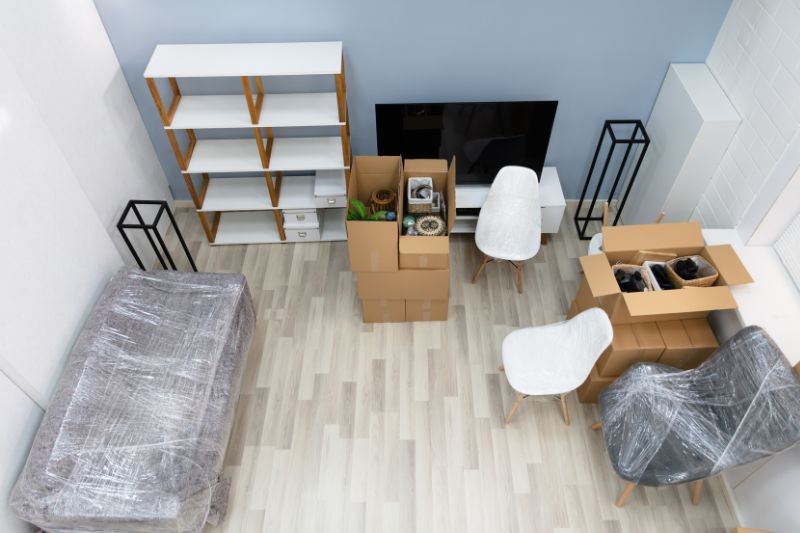No products in the cart.
A Guide to Furniture Storage
A Guide to Furniture Storage – Here’s How to Make Sure Your Beautiful Pieces Are Well-Protected

Whether you are holding on to some exquisite pieces of furniture for your future dream home or you’re into collecting antique and vintage furniture, a common issue arises – how should you store such items so that they stay in good shape long term?
Furniture storage can be quite tricky, as, on one hand, we’re dealing with large items that take up plenty of space, and, on the other hand, expensive furniture needs the right storage environment. It’s not recommended to store pieces of antique furniture, delicate upholstered pieces or high-quality wood or leather furniture in spaces such as a garage, an attic or an unfinished basement.
Your best bet for storing furniture long-term is a climate-controlled self storage unit that ensures the ideal conditions – the furniture will be protected from temperature and humidity variations and also from sunlight. These are the main steps you need to follow when preparing your furniture for storage:
Assess your furniture to make sure it’s worth storing
The first step is to ensure that your furniture is indeed worth storing. It doesn’t make much sense to pay for storing ordinary, flat-pack furniture. However, high-quality wood or leather furniture, antique and vintage pieces, particularly from famous brands, periods or designers, are timeless and their monetary value usually increases over time. So, if you own, or stumble upon such furniture, it’s smart to hold on to it. You might want to furnish your home with it sometime in the future, or you might end up selling it for cash. Either way, you’ll benefit from storing it.
Prepare the furniture for storage
Properly preparing the furniture is crucial for successful storage, particularly when it comes to long-term storage. Considering the type of furniture and its state, you need to ensure that each piece is cleaned and protected before taking it to a self storage unit:
- Use a soft cloth to thoroughly remove dust from all wood surfaces. Then, depending on the state of the furniture, you might need to wash it with some warm soapy water and allow it to dry completely – that’s recommended for furniture with visible dirt and grime. Make sure you’re not scrubbing it too vigorously, and you’re not using anything abrasive on it. Once the furniture is dusted, washed (if needed) and the surface is completely dry, apply a protective wood spray or oil.
- Gently vacuum upholstered furniture, and, if necessary, clean it with a spray of a soap made for this purpose. Always test any cleaning product on a small surface before using it on the furniture.
- Clean and polish leather furniture with dedicated products before packing it for storage; otherwise, dirt and stains will set in and will become impossible to remove.
- While cleaning your furniture, make sure you inspect its structural integrity also. Things like loose joints, chipped varnish, broken handles and so on should be dealt with before storing. If we’re talking about expensive antique furniture, it’s preferable to hire a professional specializing in restoring antiques. Repairs done improperly can drastically lower the furniture’s value.
Pack everything properly
Once all the furniture is clean and the necessary repairs are made, it’s time to start packing it. If possible, disassemble doors, drawers, shelves, and other mobile parts, and pack them individually. This makes it easier and safer to transport and store the furniture. If disassembling the furniture is not an option, it’s important to secure all doors and drawers with tape, so they don’t open during transportation. It’s also recommended to purchase corner and edge protectors to avoid any potential damages that might occur while the furniture is in storage.
Wrap each piece of furniture using plastic covers or even old sheets. If you are planning to store mattresses, it’s a good idea to purchase special mattress packing bags. In the case of upholstered furniture, you should also add some moth balls underneath the packaging.
Arrange your furniture in the storage unit
First of all, decide on the unit size that you need to rent – of course, this depends on how much furniture you plan on storing. A 10’x10’ storage unit, that’s about as big as half of a standard garage, is one of the most popular choices among people storing furniture. Such a unit allows you to store a variety of items: chest drawers, a sofa, chairs and armchairs, an armoire and a bed will most likely fit in such a unit (depending on how large the furniture is). The safest way is to measure the dimensions of each piece of furniture and to rent a unit that not only fits everything but also ensures some extra floor space for entering the unit and reaching the various stored items easily.
After you rent the unit, you should prepare it for the furniture. It’s important to keep the furniture slightly elevated from the floor to avoid humidity-related damage. Lay wooden pallets or at least some durable tarp on the unit’s floor before bringing in the furniture. Also, make sure you leave an inch or so of ventilation space between furniture and the unit’s walls.
Avoid stacking heavy items on top of the furniture: for example, a box with books placed on a wooden table could cause stains and discoloration of the varnish, even if the table is packed and covered. Similarly, placing objects on mattresses and sofas will create dents and creases.
Also, don’t forget to visit the unit regularly, every few weeks or so, to ensure that your furniture is in a good shape and to promptly remedy any problems that might occur.










Leave a Reply